Offshore Wind Turbine Market Size
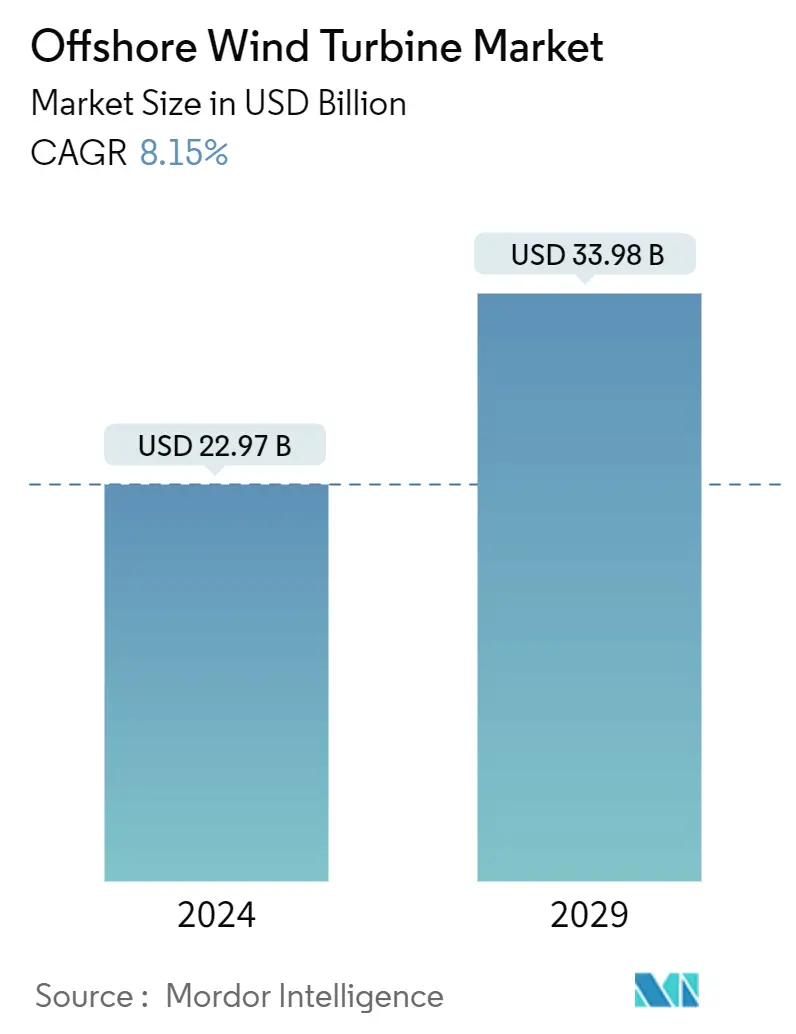
| Study Period | 2019-2029 |
| Market Size (2024) | USD 22.97 Billion |
| Market Size (2029) | USD 33.98 Billion |
| CAGR (2024 - 2029) | 8.15 % |
| Fastest Growing Market | Europe |
| Largest Market | Asia Pacific |
Major Players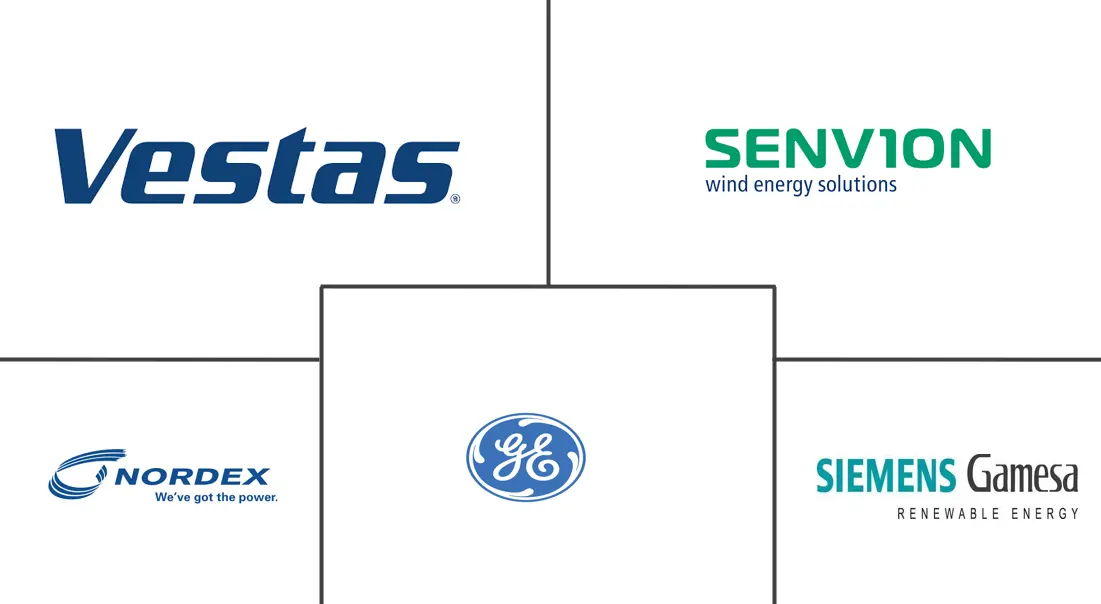
*Disclaimer: Major Players sorted in no particular order |
Offshore Wind Turbine Market Analysis
The Offshore Wind Turbine Market size is estimated at USD 22.97 billion in 2024, and is expected to reach USD 33.98 billion by 2029, growing at a CAGR of 8.15% during the forecast period (2024-2029).
Over the medium period, factors such as increasing share of renewables in the power generation mix, efforts to reduce the reliance on fossil fuel-based power generation, and regulations on energy efficiency are driving the market growth.
On the other hand, adopting clean energy sources like solar and other alternatives will likely hinder the market’s growth.
Nevertheless, the integration of AI, IoT, robotics, and data analytics in offshore wind turbines is expected to enable advanced condition monitoring and predictive maintenance, resulting in increased efficiency and reduced operational and maintenance costs, which may provide growth opportunities in the deployment of offshore wind turbines in the future.
Europe is expected to have a significant share in the market during the forecast period, as different European countries are exploring the offshore wind energy segment.
Offshore Wind Turbine Market Trends
Deepwater Segment to Witness Significant Growth
- As energy demand rises globally, major countries and companies are adopting reliable renewable energy to provide clean energy. Adopting offshore wind energy with advanced technology attracted governments and companies to invest in the sector.
- Global Wind Report 2023 showed that the total global offshore wind energy installed capacity accounted for 64 GW in 2022. With an annual growth rate of 14.3% and technological developments to overcome the installation problems in deepwater zones, the offshore wind capacity is expected to increase, which, in turn, will drive the offshore wind turbine market.
- Technological improvements, such as the increased capacity of wind turbines, floating wind turbines, and 3D printing, brought the overall cost of offshore wind power to the lowest level and opened up new offshore locations, such as deepwater, that were previously inaccessible due to lack of investment and technology. These developments are expected to augment the adoption of deepwater wind power worldwide.
- For instance, in March 2022, TotalEnergies joined Trident Winds Inc. in the Castle Wind LLC joint venture (JV) to develop a 1 GW offshore wind project off the coast of Morro Bay. The project is expected to be a deepwater project. TotalEnergies entered the joint venture, which EnBW North America previously held.
- Apart from this, the companies have recently been able to install taller wind turbines due to improvements in the wind turbine materials used, allowing the turbines to exploit higher altitude winds. Also, these new turbines have much more prominent blades and can sweep more area than smaller turbines. The growing size of wind turbines helped lower the cost of wind energy due to the economy of scale, indicating that it is economically competitive with fossil fuel alternatives in many countries, such as the United States, Germany, and France. This recent trend is expected to drive the offshore wind turbine market during the forecast period.
- By location of deployment, the deepwater offshore industry is expected to remain the driver of the wind turbine industry during the forecast period, owing to declining costs and improved technology.
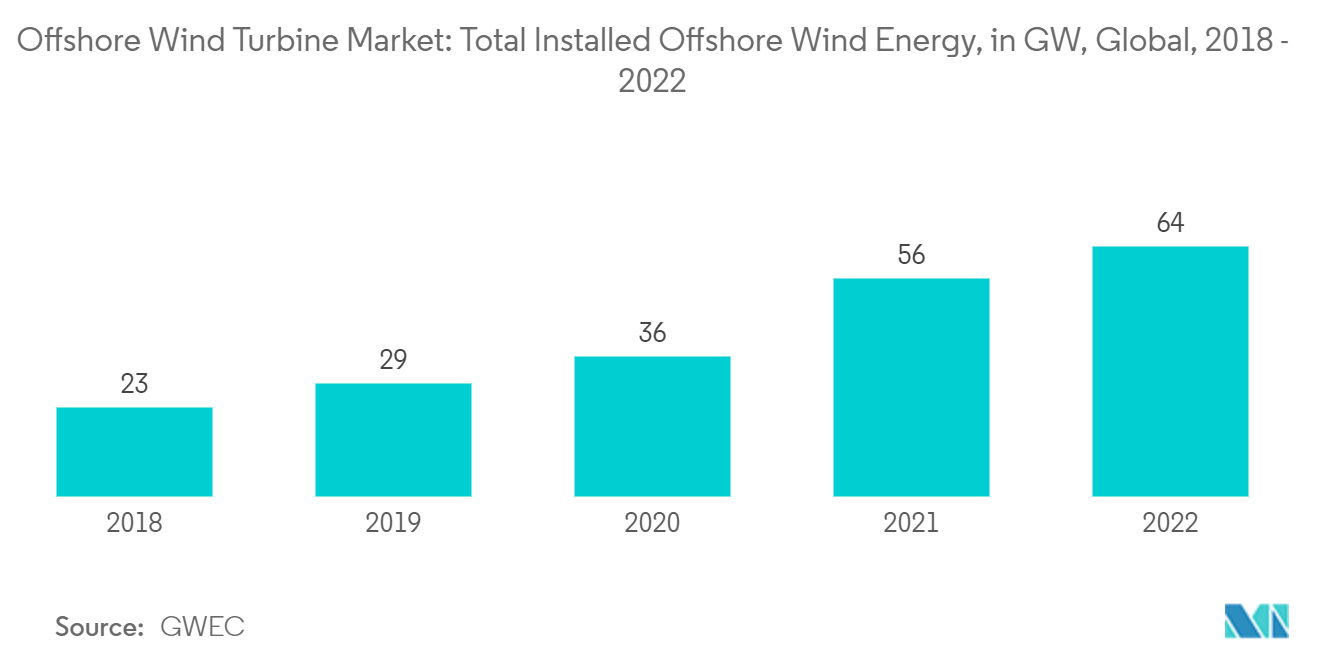
Europe is Expected to Hold the Significant Share in the Market
- Europe accounted for the second-largest share of the offshore wind power installed capacity in 2022. According to the European Union, Europe represents around a quarter of the global installations of the total wind market.
- Europe will likely be at the helm of the offshore wind market worldwide. Europe added around 2,460 MW of offshore capacity in 2022. In 2022, the region had an installed offshore wind capacity of approximately 30.27 GW, corresponding to an annual growth rate of 16% compared to the previous year.
- Even though a large percentage of the total offshore wind installations is in European waters, the governments in the North Sea region set a target for installing wind farms in their territorial waters. Nine European countries have committed to multiplying the capacity of offshore wind farms in the North Sea by eight times the current levels before 2050.
- As of 2022, Britain has 45 offshore wind farms producing 14GW, with plans to expand capacity to 50GW by 2030. Additionally, France aims to develop massively to 40GW in 2050 in renewable energy, with offshore wind energy being the primary production source between 2030 and 2050.
- Moreover, according to the Minister of Infrastructure and Energy, in March 2022, Albania was working on an offshore wind project in the Adriatic Sea supported by the European Bank for Reconstruction and Development (EBRD). The project is currently in the study phase.
- Such factors will likely bring opportunities for the players involved in the offshore wind farm business to expand in the European market during the forecast period.
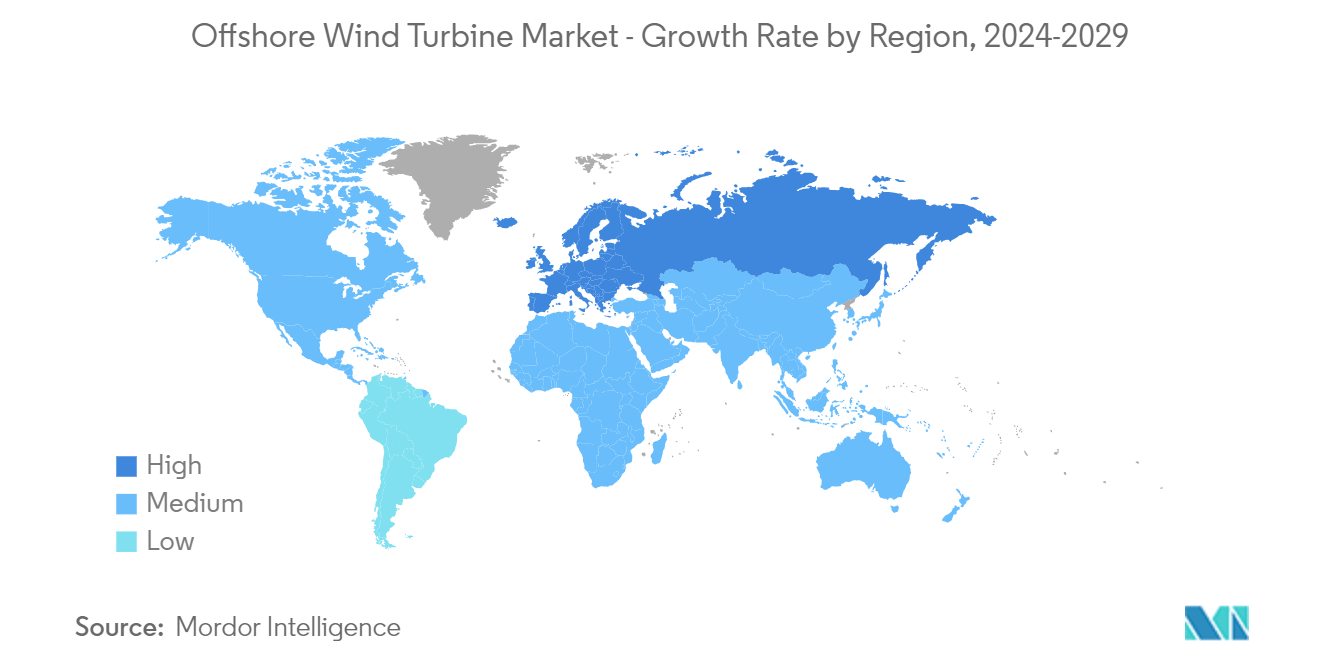
Offshore Wind Turbine Industry Overview
The offshore wind turbine market is moderately fragmented. Some of the key players in the market (in no particular order) include Vestas Wind Systems AS, Siemens Gamesa Renewable Energy SA, General Electric Company, Nordex SE, and Senvion SA., among others.
Offshore Wind Turbine Market Leaders
-
Siemens Gamesa Renewable Energy SA
-
General Electric Company
-
Nordex SE
-
Senvion SA
-
Vestas Wind Systems AS
*Disclaimer: Major Players sorted in no particular order
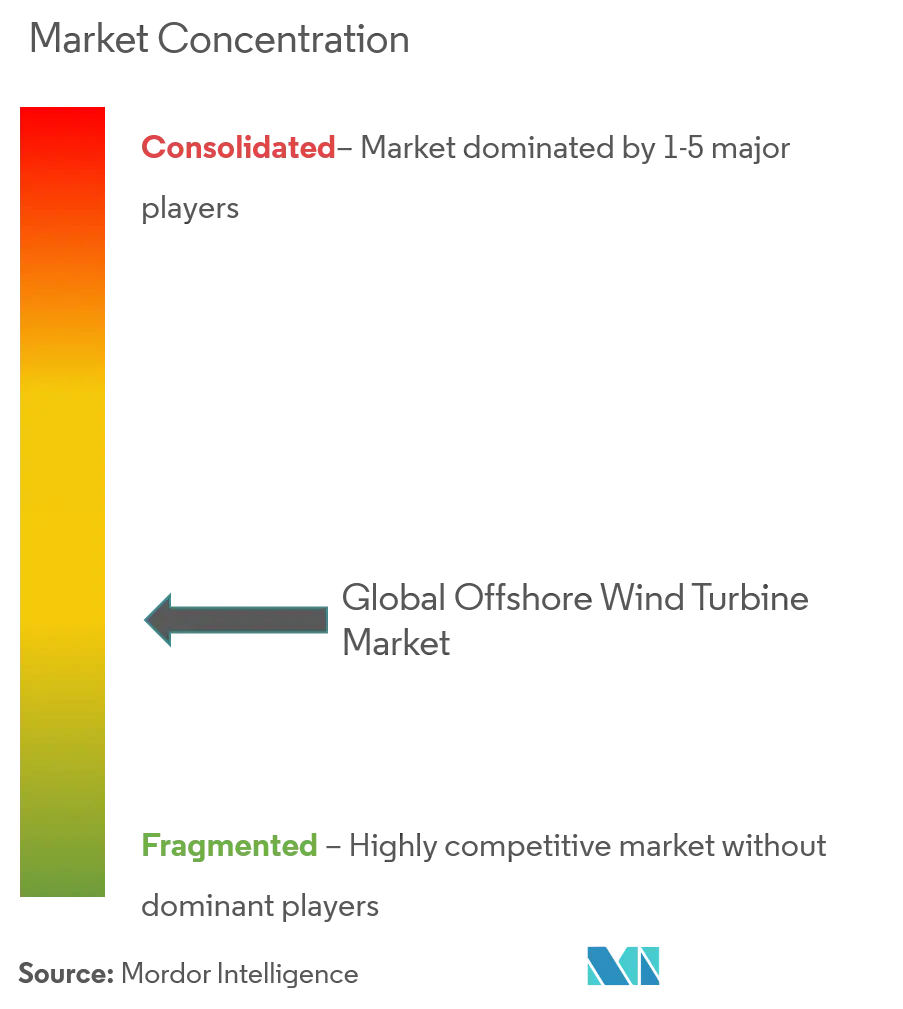
Offshore Wind Turbine Market News
- July 2023: Ocean Winds agreed to develop offshore wind projects off the coast of Victoria, Australia. The deal is a joint venture between France’s Engie and Portuguese electric utilities company EDP. The joint venture is looking to build three wind farms totaling 4 GW in the Gippsland area, declared Australia’s first offshore wind zone.
- March 2023: India announced the tender for sea-bed leasing for offshore wind projects. The tender will likely be for four blocks of sea bed in the Gulf of Mannar, off the coast of southern Tamil Nadu, each of which can accommodate 1 GW of wind power plants. Bidders will be given marks for their technical capabilities (70 percent) and the lease rent they offer for the sea bed (30 percent).
Offshore Wind Turbine Market Report - Table of Contents
1. INTRODUCTION
- 1.1 Scope of the Study
- 1.2 Market Definition
- 1.3 Study Assumptions
2. RESEARCH METHODOLOGY
3. EXECUTIVE SUMMARY
4. MARKET OVERVIEW
- 4.1 Introduction
- 4.2 Market Size and Demand Forecast in USD, till 2029
- 4.3 Key Offshore Wind Projects
- 4.4 Recent Trends and Developments
- 4.5 Government Policies and Regulations
-
4.6 Market Dynamics
- 4.6.1 Drivers
- 4.6.1.1 Rising Energy Demand
- 4.6.1.2 The Increasing Share of Renewables in the Power Generation Mix
- 4.6.2 Restraints
- 4.6.2.1 Adopting Clean Energy Sources Like Solar and Other Alternatives
- 4.7 Supply Chain Analysis
-
4.8 Porter's Five Forces Analysis
- 4.8.1 Bargaining Power of Suppliers
- 4.8.2 Bargaining Power of Consumers
- 4.8.3 Threat of New Entrants
- 4.8.4 Threat of Substitutes Products and Services
- 4.8.5 Intensity of Competitive Rivalry
5. MARKET SEGMENTATION
-
5.1 Location of Deployment
- 5.1.1 Shallow Water
- 5.1.2 Deepwater
-
5.2 Foundation Type
- 5.2.1 Fixed Foundation
- 5.2.2 Floating Foundation
-
5.3 Capacity
- 5.3.1 Less than 5 MW
- 5.3.2 Above 5 MW
-
5.4 Geography
- 5.4.1 North America
- 5.4.1.1 United States of America
- 5.4.1.2 Canada
- 5.4.1.3 Rest of the North America
- 5.4.2 Europe
- 5.4.2.1 United Kingdom
- 5.4.2.2 Germany
- 5.4.2.3 Denmark
- 5.4.2.4 Netherlands
- 5.4.2.5 Rest of the Europe
- 5.4.3 Asia-Pacific
- 5.4.3.1 China
- 5.4.3.2 Japan
- 5.4.3.3 India
- 5.4.3.4 South Korea
- 5.4.3.5 Rest of the Asia-Pacific
- 5.4.4 South America
- 5.4.4.1 Brazil
- 5.4.4.2 Argentina
- 5.4.4.3 Rest of the South America
- 5.4.5 Middle-East and Africa
- 5.4.5.1 United Arab Emirates
- 5.4.5.2 Saudi Arabia
- 5.4.5.3 Rest of the Middle-East and Africa
6. COMPETITIVE LANDSCAPE
- 6.1 Mergers and Acquisitions, Joint Ventures, Collaborations, and Agreements
- 6.2 Strategies Adopted by Leading Players
-
6.3 Company Profiles
- 6.3.1 Vestas Wind Systems AS
- 6.3.2 Siemens Gamesa Renewable Energy SA
- 6.3.3 General Electric Company
- 6.3.4 Nordex SE
- 6.3.5 Senvion SA
- 6.3.6 Suzlon Energy Ltd
- 6.3.7 Xinjiang Goldwind Science & Technology Co. Ltd.
- 6.3.8 Guodian United Power Technology Company Limited
- 6.3.9 Enercon GmbH
- 6.3.10 Envision Energy Limited
- 6.3.11 Hitachi Ltd.
- *List Not Exhaustive
- 6.4 Market Ranking/Share Analysis
7. MARKET OPPORTUNITIES AND FUTURE TRENDS
- 7.1 The Integration of AI, IoT, Robotics, and Data Analytics in Offshore Wind Turbines
Offshore Wind Turbine Industry Segmentation
Offshore wind turbines operate by transforming the kinetic energy in the wind over water into rotational kinetic energy used to generate electricity. Turbines can be installed both in ocean waters and inland lakes and are typically around 80-100 meters high with a rotor blade diameter of 20-50 meters.
The offshore wind turbine market is segmented by location, foundation type, capacity, and geography (North America, Europe, Asia-Pacific, South America, and the Middle East and Africa). By location, the market is segmented into shallow water and deep water. By foundation type, the market is segmented into fixed foundation and floating foundation. By capacity, the market is segmented into less than 5 MW and above 5 MW.
The report offers the market size and forecasts for offshore wind turbines in revenue (USD) for all the above segments.
For each segment, the market sizing and forecasts have been done based on revenue (USD).
| Location of Deployment | Shallow Water | |
| Deepwater | ||
| Foundation Type | Fixed Foundation | |
| Floating Foundation | ||
| Capacity | Less than 5 MW | |
| Above 5 MW | ||
| Geography | North America | United States of America |
| Canada | ||
| Rest of the North America | ||
| Geography | Europe | United Kingdom |
| Germany | ||
| Denmark | ||
| Netherlands | ||
| Rest of the Europe | ||
| Geography | Asia-Pacific | China |
| Japan | ||
| India | ||
| South Korea | ||
| Rest of the Asia-Pacific | ||
| Geography | South America | Brazil |
| Argentina | ||
| Rest of the South America | ||
| Geography | Middle-East and Africa | United Arab Emirates |
| Saudi Arabia | ||
| Rest of the Middle-East and Africa |
Offshore Wind Turbine Market Research FAQs
How big is the Offshore Wind Turbine Market?
The Offshore Wind Turbine Market size is expected to reach USD 22.97 billion in 2024 and grow at a CAGR of 8.15% to reach USD 33.98 billion by 2029.
What is the current Offshore Wind Turbine Market size?
In 2024, the Offshore Wind Turbine Market size is expected to reach USD 22.97 billion.
Who are the key players in Offshore Wind Turbine Market?
Siemens Gamesa Renewable Energy SA, General Electric Company, Nordex SE, Senvion SA and Vestas Wind Systems AS are the major companies operating in the Offshore Wind Turbine Market.
Which is the fastest growing region in Offshore Wind Turbine Market?
Europe is estimated to grow at the highest CAGR over the forecast period (2024-2029).
Which region has the biggest share in Offshore Wind Turbine Market?
In 2024, the Asia Pacific accounts for the largest market share in Offshore Wind Turbine Market.
What years does this Offshore Wind Turbine Market cover, and what was the market size in 2023?
In 2023, the Offshore Wind Turbine Market size was estimated at USD 21.10 billion. The report covers the Offshore Wind Turbine Market historical market size for years: 2019, 2020, 2021, 2022 and 2023. The report also forecasts the Offshore Wind Turbine Market size for years: 2024, 2025, 2026, 2027, 2028 and 2029.
Offshore Wind Turbine Industry Report
Statistics for the 2024 Offshore Wind Turbine market share, size and revenue growth rate, created by Mordor Intelligence™ Industry Reports. Offshore Wind Turbine analysis includes a market forecast outlook to 2029 and historical overview. Get a sample of this industry analysis as a free report PDF download.



